Riku Jäntti
Ambient Backscatter Communication in LTE Uplink Sounding Reference Signal
Jan 19, 2025Abstract:Ambient Internet of Things (AIoT), recently standardized by the 3rd Generation Partnership Project (3GPP), demands a low-power wide-area communication solution that operates several orders of magnitude below the power requirements of existing 3GPP specifications. Ambient backscatter communication (AmBC) is considered as a competitive potential technique by harvesting energy from the ambient RF signal. This paper considers a symbiotic AmBC into Long Term Evolution (LTE) cellular system uplink. Leveraging by LTE uplink channel estimation ability, AIoT conveys its own message to Base Station (BS) by modulating backscatter path. We explore the detector design, analyze the error performance of the proposed scheme, provide exact expression and its Guassian approximation for the error probability. We corroborate the receiver error performance by Monte Carlo simulation. Analysis of communication range reveals AmBC achieves a reasonable BER of order of magnitude $10^{-2}$ within four times wavelength reading distance. In addition, a AmBC prototype in LTE uplink confirms the its feasibility. The over-the-air experiment results validate theoretical analysis. Hence, the proposed AmBC approach enables AIoT deployment with minimal changes to the LTE system.
Thin Film Reconfigurable Intelligent Surface for Harmonic Beam Steering
Jun 10, 2024Abstract:This letter explores the development and implementation of a novel thin film 1-by-4 reconfigurable intelligent surface (RIS) designed for future communication and sensing scenarios. Utilizing cost-effective inkjet printing methods and additive manufacturing, our approach significantly simplifies the RIS construction process and reduces production costs. The RIS, fabricated on a flexible and lightweight polyethylene terephthalate (PET) substrate, integrates antennas, switching circuitry, and a microcontroller unit (MCU). This setup enables individual and simultaneous control of each RIS element, manipulating the captured carrier signal by steering its dominant harmonics toward multiple desired directions. Measurement results of the beam steering show the manufactured RIS has the potential to enable RIS-aided communication and sensing applications.
Generative AI for Immersive Communication: The Next Frontier in Internet-of-Senses Through 6G
Apr 02, 2024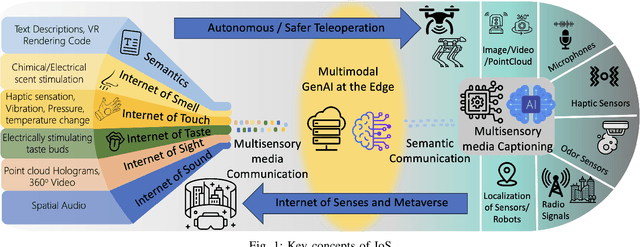
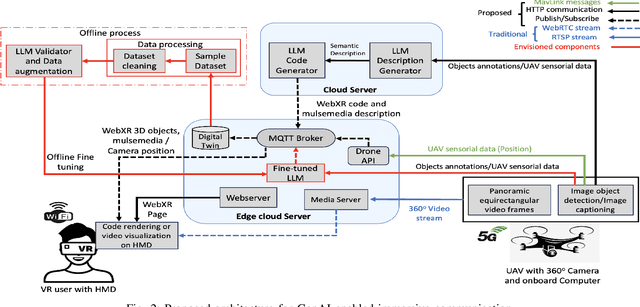
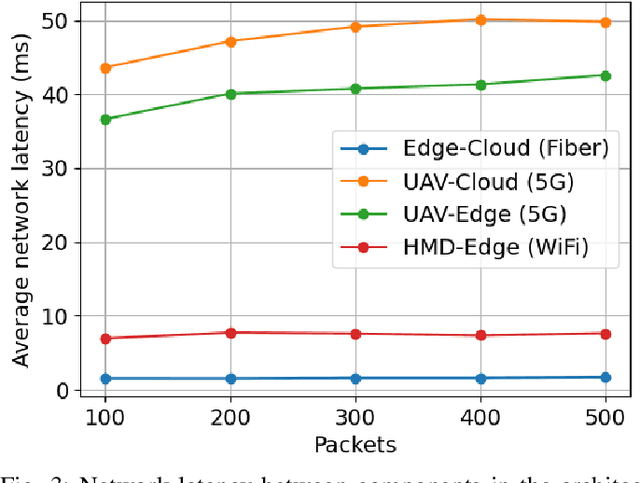
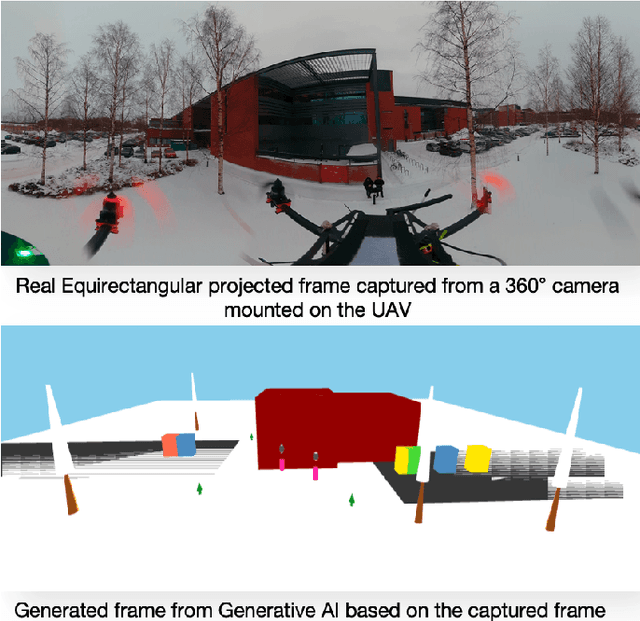
Abstract:Over the past two decades, the Internet-of-Things (IoT) has been a transformative concept, and as we approach 2030, a new paradigm known as the Internet of Senses (IoS) is emerging. Unlike conventional Virtual Reality (VR), IoS seeks to provide multi-sensory experiences, acknowledging that in our physical reality, our perception extends far beyond just sight and sound; it encompasses a range of senses. This article explores existing technologies driving immersive multi-sensory media, delving into their capabilities and potential applications. This exploration includes a comparative analysis between conventional immersive media streaming and a proposed use case that leverages semantic communication empowered by generative Artificial Intelligence (AI). The focal point of this analysis is the substantial reduction in bandwidth consumption by 99.93% in the proposed scheme. Through this comparison, we aim to underscore the practical applications of generative AI for immersive media while addressing the challenges and outlining future trajectories.
Zero-energy Devices for 6G: Technical Enablers at a Glance
Feb 14, 2024Abstract:Low-cost, resource-constrained, maintenance-free, and energy-harvesting (EH) Internet of Things (IoT) devices, referred to as zero-energy devices (ZEDs), are rapidly attracting attention from industry and academia due to their myriad of applications. To date, such devices remain primarily unsupported by modern IoT connectivity solutions due to their intrinsic fabrication, hardware, deployment, and operation limitations, while lacking clarity on their key technical enablers and prospects. Herein, we address this by discussing the main characteristics and enabling technologies of ZEDs within the next generation of mobile networks, specifically focusing on unconventional EH sources, multi-source EH, power management, energy storage solutions, manufacturing material and practices, backscattering, and low-complexity receivers. Moreover, we highlight the need for lightweight and energy-aware computing, communication, and scheduling protocols, while discussing potential approaches related to TinyML, duty cycling, and infrastructure enablers like radio frequency wireless power transfer and wake-up protocols. Challenging aspects and open research directions are identified and discussed in all the cases. Finally, we showcase an experimental ZED proof-of-concept related to ambient cellular backscattering.
RIS Position and Orientation Estimation via Multi-Carrier Transmissions and Multiple Receivers
Nov 15, 2023



Abstract:Reconfigurable intelligent surfaces (RISs) are considered as an enabling technology for the upcoming sixth generation of wireless systems, exhibiting significant potential for radio localization and sensing. An RIS is usually treated as an anchor point with known position and orientation when deployed to offer user localization. However, it can also be attached to a user to enable its localization in a semi-passive manner. In this paper, we consider a static user equipped with an RIS and study the RIS localization problem (i.e., joint three-dimensional position and orientation estimation), when operating in a system comprising a single-antenna transmitter and multiple synchronized single-antenna receivers with known locations. We present a multi-stage estimator using time-of-arrival and spatial frequency measurements, and derive the Cram\'er-Rao lower bounds for the estimated parameters to validate the estimator's performance. Our simulation results demonstrate the efficiency of the proposed RIS state estimation approach under various system operation parameters.
Joint User Localization and Location Calibration of A Hybrid Reconfigurable Intelligent Surface
Oct 18, 2022


Abstract:The recent research in the emerging technology of reconfigurable intelligent surfaces (RISs) has identified its high potential for localization and sensing. However, to accurately localize a user placed in the area of influence of an RIS, the RIS location needs to be known a priori and its phase profile is required to be optimized for localization. In this paper, we study the problem of the joint localization of a hybrid RIS (HRIS) and a user, considering that the former is equipped with a single reception radio-frequency (RF) chain enabling simultaneous tunable reflections and sensing via power splitting. Focusing on the downlink of a multi-antenna base station, we present a multi-stage approach for the estimation of the HRIS position and orientation as well as the user position. Our simulation results, including comparisons with the Cram\'er-Rao lower bounds, demonstrate the efficiency of the proposed localization approach, while showcasing that there exists an optimal HRIS power splitting ratio for the desired multi-parameter estimation problem.
Channel Model Mismatch Analysis for XL-MIMO Systems from a Localization Perspective
May 30, 2022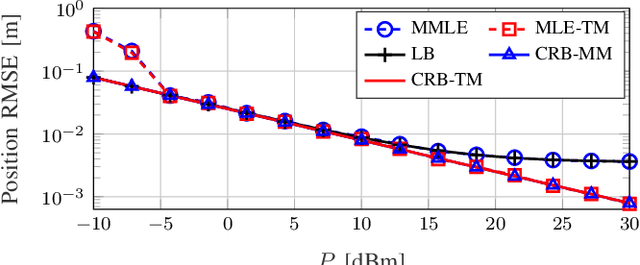
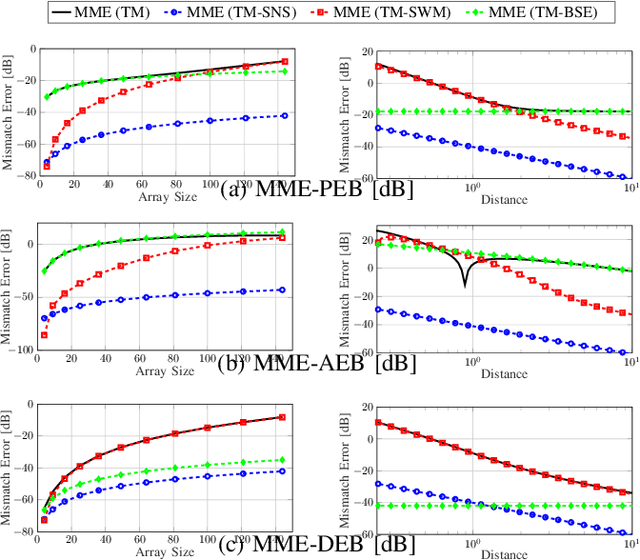


Abstract:Radio localization is applied in high-frequency (e.g., mmWave and THz) systems to support communication and to provide location-based services without extra infrastructure. {For solving localization problems, a simplified, stationary, narrowband far-field channel model is widely used due to its compact formulation.} However, with increased array size in extra-large MIMO systems and increased bandwidth at upper mmWave bands, the effect of channel spatial non-stationarity (SNS), spherical wave model (SWM), and beam squint effect (BSE) cannot be ignored. In this case, localization performance will be affected when an inaccurate channel model deviating from the true model is adopted. In this work, we employ the MCRB (misspecified Cram\'er-Rao lower bound) to lower bound the localization error using a simplified mismatched model while the observed data is governed by a more complex true model. The simulation results show that among all the model impairments, the SNS has the least contribution, the SWM dominates when the distance is small compared to the array size, and the BSE has a more significant effect when the distance is much larger than the array size.
Covert backscatter communication with directional MIMO
Feb 08, 2022Abstract:We study a backscatter communication protocol over a AWGN channel, where a transmitter illuminates a tag with a directional multi-antenna. The tag performs load modulation on the signal while hiding its physical presence from a warden. We show that, if the transmitter-to-tag channel is inaccessible to the warden, then $\Theta(n)$ reliable and covert bits can be transmitted over $n$ channel usages. This overcomes the square-root law for covert communication. This paper provides the first evidence for practical implementation of covert backscatter communication, with potential applications in IoT security.
 Add to Chrome
Add to Chrome Add to Firefox
Add to Firefox Add to Edge
Add to Edge